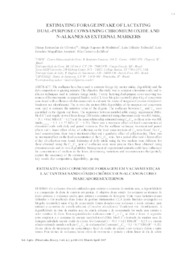Estimating forage intake of lactating dual-purpose cows using chromium oxide and n-alkanes as external markers.
Estimating forage intake of lactating dual-purpose cows using chromium oxide and n-alkanes as external markers.
Author(s): OLIVEIRA, D. E. de; MEDEIROS, S. R. de; TEDESCHI, L. O.; AROEIRA, L. J. M.; SILVA, S. C. da
Summary: The n-alkanes have been used to estimate forage dry matter intake, digestibility and the diet composition in grazing animals. The objective this study was to compare chromium oxide and n-alkanes techniques used to estimate forage intake. Twenty lactating dual-purpose cows receiving two sources of fat (treatments: conjugated linoleic acid (CLA) or Megalac (control)) plus 4 kg of concentrate were dosed with n-alkanes and chromium oxide to estimate the intake of stargrass (Cynodon nlemfüensis Vanderyst var. nlemfüensis). The in vitro dry matter (DM) digestibility of the stargrass and concentrate were used to estimate the nutritive value of the digesta. The n-alkanes between C23 and C36 were quantified in the digesta and feces. The regression between metabolizable energy requirement (MEr, Mcal d-1) and supply derived from forage DM intake estimated using chromium oxide was ME IntakeCr = 19.1 + 0.62 MEr (R² = 0.27) and the same relationship estimated using C35:C36 n-alkane ratio was ME IntakeC35:C36 = 9.3 + 0.77 MEr (R² = 0.52). There was a treatment effect on fecal concentration of chromium oxide with daily and period variations. For the n-alkane technique, treatment and period effects and a linear effect of day of collection on the fecal concentrations of C35 were found. For C36 fecal concentrations, there was a treatment effect and a quadratic effect of collection day. There was no treatment effect on the fecal concentration of the C35:C36 ratio, but a period effect and a linear effect of day of collection were found. Estimates of daily intake using the two markers were different, but those obtained using the C35:C36 pair of n-alkanes were more precise than those obtained using chromium oxide and in vitro digestibility. Management of experimental animals could have influenced the concentration of markers in the feces, determining variations and inconsistencies that partially explain the inaccuracy of the estimates.
Publication year: 2007
Types of publication: Journal article
Unit: Embrapa Dairy Cattle
Keywords: Diet composition, animal nutrition, digestibility, grazing
Observation
Some of Embrapa's publications are published as ePub files. To read them, use or download one of the following free software options to your computer or mobile device. Android: Google Play Books; IOS: iBooks; Windows and Linux: Calibre.
Access other publications
Access the Agricultural Research Database (BDPA) to consult Embrapa's full library collection and records.
Visit Embrapa Bookstore to purchase books and other publications sold by Embrapa.

